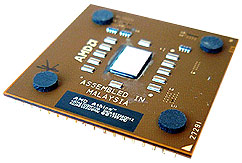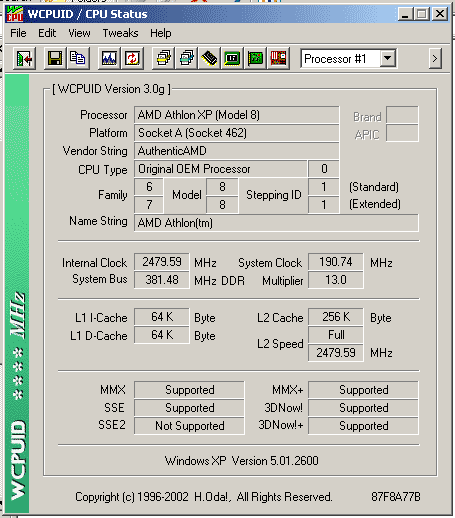Overclocking the AthlonXP 2700+
 The AthlonXP 2700+ is multiplier
locked by default even though all the L1 bridges on the PCB are
connected. I would have unlocked the processor via the last L3 bridge but I
didn't have any conductive paint left in the lab, so we'll come back to that in
few days. The AthlonXP 2700+ is multiplier
locked by default even though all the L1 bridges on the PCB are
connected. I would have unlocked the processor via the last L3 bridge but I
didn't have any conductive paint left in the lab, so we'll come back to that in
few days.
The only way to overclock a locked processor is
through the FSB and please remember that we're already starting at 166
MHz. The XP 2700+ uses the same AIUAB we found on the XP 2400+ we tested earlier
but hopefully we'll be able to squeeze a bit more out of the XP 2700+ then we
did the XP 2400+which topped off at 2.25 GHz .
 |
| The last letter of the first
line signifies the FSB. A=100 MHz, C=133 MHz, D= 166
MHz |
One thing I've noticed after playing with a few
Thoroughbred processors is that overclocking is a much wilder ride. What I mean
is that it's much harder to find the absolute maximum speed and keep 100%
stability at the same time.
For instance, it's possible to overclock a
Thoroughbred processor to a high value (say 2.4GHz) and at that speed it will
run 3DMark, Quake III, Sandra and even SysMark perfectly, but crash in
POVRay.
Keeping that in mind, it was a bit frustrating
finding the true overclocking potential of the AthlonXP 2700+ we tested (which
was incidently pre-production silicon).
After a few tries, we found a few sweet spots, and
this time around I was a patient overclocker. I increased the FSB slowly about
3-4 MHz at a time and ultimately hit the first snag at 173 MHz FSB. I increased
the VCore from 1.65v to 1.75v to stabilize the processor and then continued
upward.
We began to encounter a few more overclocking bumps
almost immediately once the processor hit 180 MHz FSB. To stabilize things this
time I increased the Vcore to 1.85V! Stability looked good after this, and to my
surprise, the system would complete a full run of 3DMark, Quake III and Sandra
at 190 MHz FSB (which would give me a CPU speed of 2.47 GHz). For some reason,
the AthlonXP 2700+ we tested would always fail SuperPi whenever it was pushed
above 185MHz FSB - no matter what the voltage to the core.

In the end I settled with a stable 185 MHz FSB
which gave us a maximum clock speed of 2.4GHz - still pretty
impressive.
I have never seen these peculiar overclocking
traits with any other processors we've tested from the Thunderbird Athlon's to
Palomino's or even the Pentium 4, just with the Thoroughbred. Weird.
|
